Lesson ideas: Primary and lower secondary school
3 “Let’s have a party!”: Teaching students how to express, accept and refuse invitations
Selke Tombrägel
1 Introduction and rationale
Communicative approaches to teaching English as a foreign or second language aim to enable learners to master key communicative situations such as going to a restaurant, shopping, asking for directions, etc. As such, it is necessary to give students the opportunity to come into contact with authentic spoken language as opposed to the largely written-language-based and often unidiomatic materials presented in school textbooks. With this in mind, this chapter applies a communicative teaching approach by teaching students how to give, accept and refuse invitations in a socially accepted manner. This teaching objective is in line with our local secondary school curriculum, which states that students should be able to invite somebody and to respond to invitations (Niedersächsisches Kultusministerium 2015: 17). This chapter provides teachers with a detailed step-by-step guide on how to access and compile idiomatic spoken language material by conducting their own corpus linguistics research and how to process this material for teaching purposes. It thus shows how idiomatic spoken language use can form the basis of diverse communicative and meaningful learner activities, which prepare students for communicative encounters outside the classroom.
Outline and objectives
- Target learners: Lower secondary school (e.g. 8th grade)
- Teacher preparation time: ca. 60 min.
- Lesson time: ca. 90 min.
By the end of this lesson, students will be able to:
- Invite friends to a party
- Accept invitations in spoken English
- Politely refuse invitations in spoken English
2 Corpus, tools and methods
Quaglio (2009: 148-149) advocates the use of television dialogue as a surrogate for natural conversation, adding that “it offers a vast potential for pedagogical purposes”. Accordingly, the Corpus of American Soap Operas was selected for this lesson. It contains 100 million words of spoken American English from ten US soap operas from the early 2000s and is freely accessible via english-corpora.org. Note that, unlike many spoken corpora, which feature adult, uncensored spoken language, the Corpus of American Soap Operas is especially adequate for selecting language material for younger learners, as it does not include any swear words. To use the english-corpora.org, users will need to register. The free account only offers a limited number of searches per day but this is sufficient for teaching purposes.
The corpus research conducted by the teacher as part of the preparation for this lesson focuses on the KWIC functions of english-corpora.org. This function is particularly useful because it can help to counter the “over-emphasis in language teaching on single words” (O’Keeffe et al. 2007: 63); and to make students aware that “the meaning of a word is as much a matter of how it combines with other words in actual use” (Firth 1935 in O’Keeffe et al. 2007: 59).
3 Step-by-step guide
3.1 Teacher preparation – data collection
Step 1: Registering on english-corpora.org
To access the Corpus of American Soap Operas, connect to www.english-corpora.org and select the corpus by clicking on it (Fig. 1).

If you are curious to find out more about the different soaps included in the corpus, click on the “sheet-of-paper symbol” (Fig. 2).

Step 2: Compiling corpus data with the “KWIC” function
The “Keyword in Context” (KWIC) function enables you to see in which context a keyword, occurs. First, type in the keyword, in this case invite. Second, select the words by which you want to sort your search. Select L for 1, 2, or 3 words to the left. Select R for 1, 2, or 3 words to the right. It is also possible, for example, to sort by one word to the left, then one and two words to the right. Note that you can click on the grey box with the asterisk to clear the entries and start over (Fig. 3).
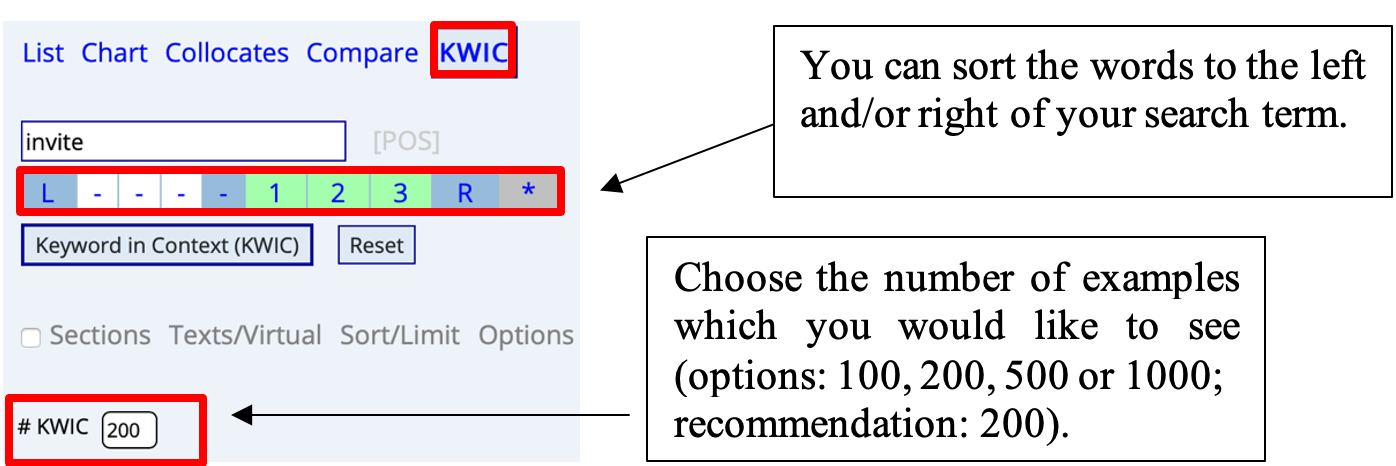
As a result of this sample search, you will obtain a list of 200 examples of the verb invite and the three words to its right (Fig. 4). Elements which belong to the same structural category are highlighted in the same colour, which will help you and your students to identify common patterns of usage.
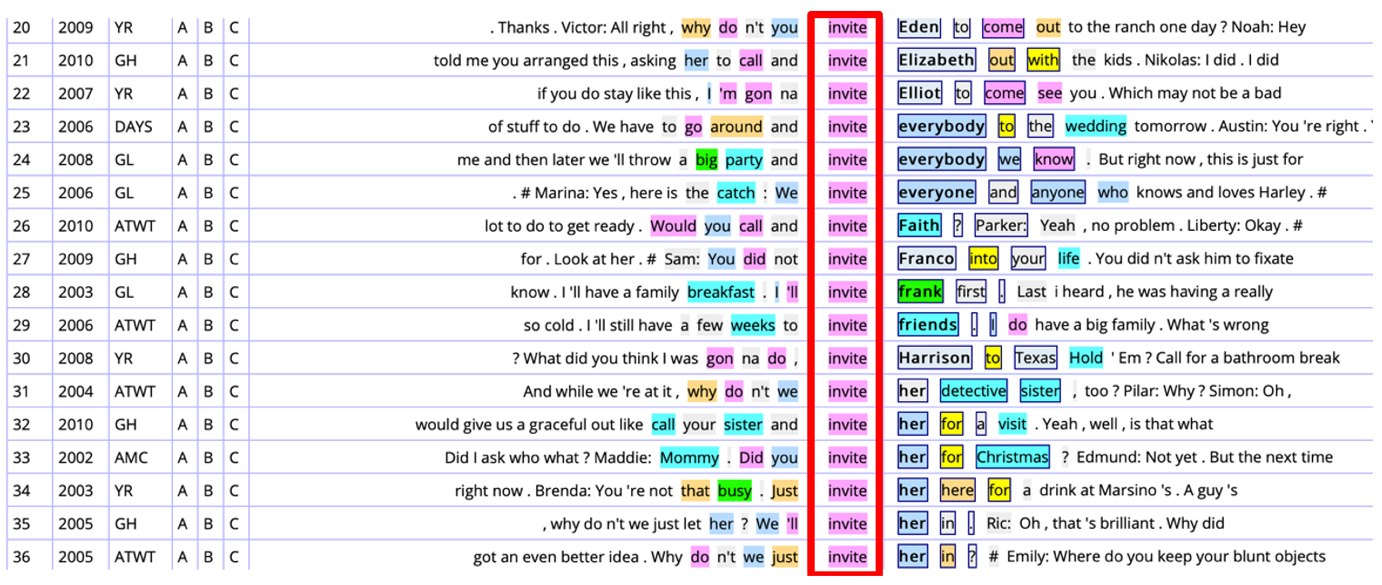
You may have observed that the search options, as displayed in Fig. 3, only returned the non-inflected verb form invite. In order to find representative examples including the different conjugated forms of the verb invite (e.g. he/she/it invites, he was invited) (Fig. 6), you need to search for the lemma invite. The lemma includes all conjugated verb forms such as inviting, invited, invites etc. To search for the lemma invite, type: [invite] or INVITE and click on “Keyword in Context (KWIC)” (Fig. 5).
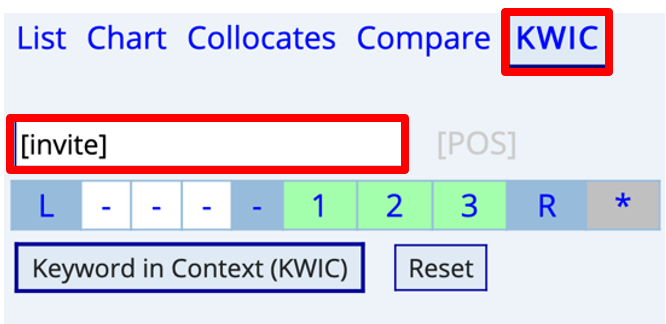
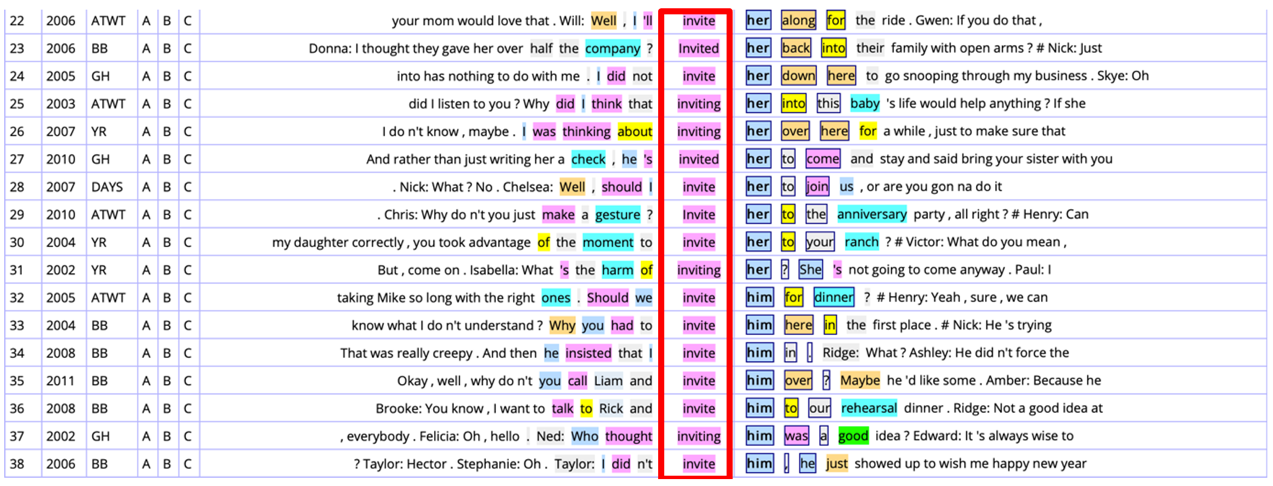
Step 3: Searching for particular parts-of-speech
When looking for similar patterns, it is important to search for invite as either a noun or a verb in order to obtain comparable examples. This selection can be made by clicking on the light grey button “POS” (= Part-of-Speech) next to where the search term is entered (Fig. 7). A drop-down menu opens and “verb.all” or “noun.all” can be selected.
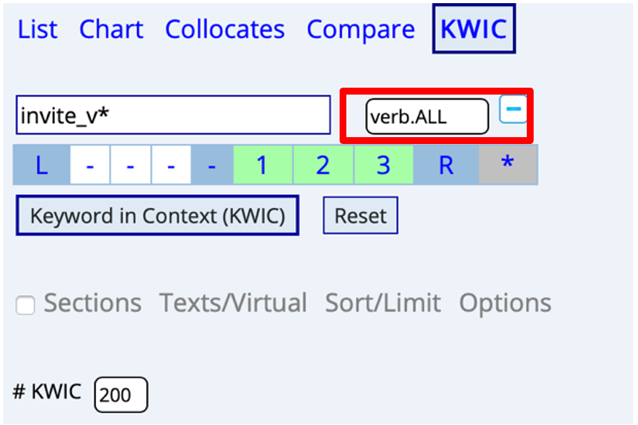
In the following you will find some results for exemplary searches of invite as a verb.



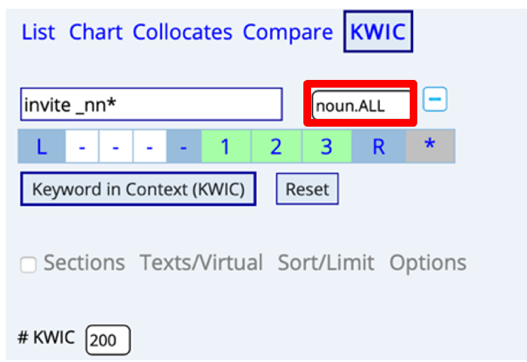
Now also search for the nouns invite and invitation.

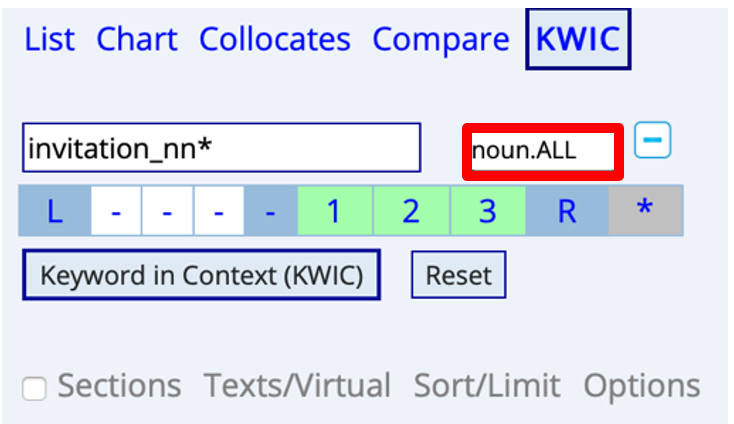

Step 4: Documenting research results
Having familiarized yourself with the KWIC feature of the corpus and skimmed through the examples, you now need to select data suitable for your lesson which exemplify the speech act of “inviting somebody”. English-corpora.org offers you the useful option of creating your own lists containing only the examples which are most interesting or relevant for your teaching purposes. To save individual examples, simply click on all the examples that you would like to use in class (they will be highlighted in blue), give your list a name in the textbox (Number 4 in Fig. 15) and click on “SAVE LIST”. You can also add to lists that you have previously created by selecting the list name in the dropdown menu (Number 3 in Fig. 15).
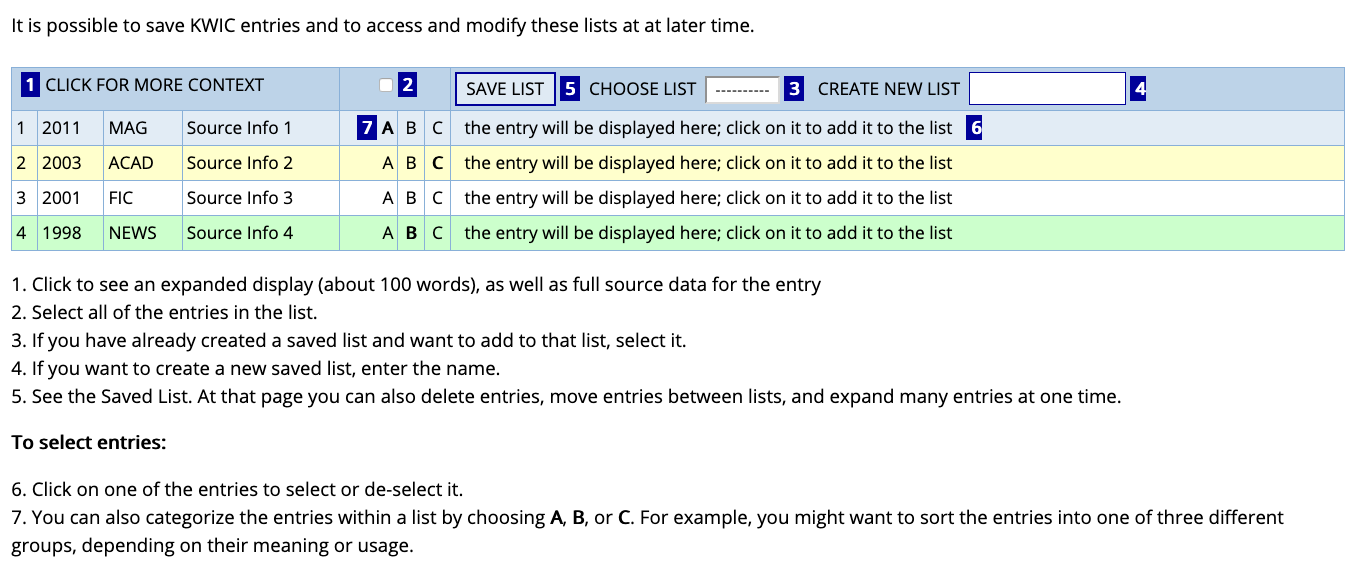
One option is to save lists of useful frequent structures, e.g. invite + me/him/her/them + over/to, so that your students may inductively infer the underlying patterns based on the similarity of the examples. You can access your lists anytime. Choose the list you would like to access and click on “SAVE LIST” (Fig. 16).


Alternatively, you may copy the examples and/or the expanded contexts into an empty Word document to use this data for the preparation of teaching material. Either way, you should document your research results as it forms the basis for preparing your teaching materials.
Step 5: Categorizing research results
Based on your research results, you can now categorize the examples you selected according to your teaching objectives. The table below presents such an example categorization.
|
Give/express an invitation |
Accept an invitation |
Refuse an invitation |
|
|
|
3.2 Teacher preparation – designing corpus-based teaching materials
Warm-up
Step 6: Selecting a video scene of an invitational act
For the warm-up activity, select an appropriate invitation scene, ideally from one of the soaps in the corpus. The expanded context information of a specific concordance line as illustrated below (Fig. 18), includes information about the date on which this specific scene was first broadcasted. Therefore, you may try to search the internet to find this specific episode, though this can be a time-consuming task! Alternatively, search for an alternative invitation scene on YouTube, e.g. from the soap “All my children” (on YouTube, search for: “All my children invitation”): https://www.youtube.com/watch?v=3awzuCGbqqo.

Pre-task
Step 7: Preparing playing cards
This interactive pre-task is designed to focus the students’ attention onto the diverse contexts, in which the two most basic terms linked to the topic of invitation (invite and invitation) may occur. To create the pre-task material, access your list(s) of examples which you have saved on the English-corpora website (step 4) or as the Word document you created. Split a selection of these sentences into meaningful chunks of two to five words. Print or write the individual chunks onto large, colourful cards.
| I would very much like | to invite you | to come |
| Thanks | for the invite | but I can’t stay |
First task
Step 8: Designing a worksheet based on the KWIC material
For the first task, you need to design a worksheet based on the corpus data which you compiled through your KWIC research (Step 2). Basically, you provide the students with blocks of examples which illustrate recurrent patterns.

Please note that Fig. 19 is a sample worksheet and that you should add further examples.
Second task
Step 9: Designing role-play cards
While the first task focused the students’ attention on patterns of usage, the second task aims to motivate students to actively use these patterns in communication. In order to achieve this aim, it is recommended to create role-play cards. The corpus data you collected (in the form of concordance lines and their expanded contexts) offer numerous example situations which you can use for creating the cards. You can either directly copy the “expanded context” onto the cards if the situation is clear enough that way, or rephrase and summarize the depicted scene in a couple of sentences if necessary. While the situation is presented on the back of the card, the front side states the topic of the situation e.g. “Refusing an invitation” (Table 3).
|
– front – Inviting somebody
|
– back – Situation: You have decided to celebrate your birthday, which is coming up the following week. On your way to soccer practice you meet a good friend and immediately want to invite him/her.
|
|
– front – Refusing an invitation
|
– back – Situation: Your best friend invites you to his/her birthday. Unfortunately, you will be on vacation with your parents. |
Third task
Step 10: Formulating the final task of the session
The final task of the session requires the students to practise using the structural patterns and phrases they have learned over the course of the session in writing by designing an invitation card (Fig. 20).

Task 3
Write an invitation card for an imaginary party. Don’t forget to mention:
- What you are celebrating
- The date, time and place
- What the guests should bring
- Information on how to respond to your invitation.
Lesson plan
|
Phase |
Task |
Implementation |
Interaction form |
Material/Medium |
|
Warm-up 10 min |
Video impulse “invitation” |
Quick impulse Video Discussion on the video |
plenum |
YouTube video |
|
Pre-task 20 min |
Guess what comes before and after! |
Reorganizing cards on the board Discussion of results |
group work/ plenum |
Cards for the board (and/or groupwork) |
|
Task 1 20 min |
Hands-on KWIC |
Working with concordance lines, discovering structural patterns and useful phrases Comparing results |
Individually/ partner work/ plenum |
worksheet |
|
Task 2 25 min |
Role-Play |
Practicing new structures and phrases in communication Presentation of mini role plays |
partner work plenum |
Role-play cards |
|
Task 3 15 min |
Designing an invitation card |
Writing an invitation card! Homework: finish it! |
individually |
Sample card via document camera |
Instructions
Pre-Task: Language chunk cards
The idea is to pin a number of sentence “chunks” onto the board. In a class of 24 students, form four groups of six students. Within their groups, the students discuss and guess which of the chunks presented on the board belong together. Each group then sends one group member to the board to reorganize the chunks in the correct order. The group results are then discussed in class and secured on the board.
First task: Discovery learning of key patterns
In this task, students work through the worksheet designed in 3.2.3 individually or in pairs. Depending on the class, time resources and classroom facilities, this task could also be redesigned as a hands-on Data-Driven-Learning (DDL) task. In this case, the students themselves work online with the corpus. This, of course, means that they need access to computers and should have received a general introduction to corpus research similar to the one provided for teachers in this chapter. If these requirements can be met, the students work “hands-on” with the corpus in order to discover structural patterns. Instead of being given the pre-selected corpus data, they can investigate and select examples sentences themselves.
Second task: Role-plays
The class is split into pairs of two students: each pair receives approximately ten role-play cards; the students then have to act out the described situation by choosing appropriate phrases/patterns to talk about invitations. They can use the worksheet; especially task 1b (see worksheet Fig. 20) may help them to decide which structure to use in which situation.
Third task: Invitation cards
This task can conclude the lesson or, alternatively, be set as homework. Weaker students may be provided with an example invitation text to support them in this task.
4 Options and further ideas
As an extension to the invitation card writing task, students can “invite” each other to their parties and then accept or refuse invitations on the basis of a roll of the dice. The number on the dice can be suggested by the students and then summarized on the board.
Possible key to the die game
1 = Accept the invitation.
2 = Accept the invitation and ask if your friend/sibling can also come.
3 = Accept the invitation and offer to bring something.
4 = Accept the invitation but warn that you can only come an hour later.
5 = Refuse the invitation. You have something else planned.
6 = Refuse the invitation. You are already invited to another party.
Further follow-up lessons could focus students’ attention on the degree of politeness in various invitation scenes, particularly with regard to the modal verbs used to express politeness. The following combinations are particularly frequent in the corpus:
- Would + invitation
- Would love to + invite
- Couldn’t + invite
- May + invite
- Should + invite
- Should have a party
- Ought to + invite
The following search (Fig. 21) can help to find the most frequent modal verb + invite patterns.

In the corpus examples below, the speakers often use specific words to express what they are saying in a specific manner. Can you find these words?
Knock on door. Alexis: Hi. James: Hello. I believe these belong to you. Alexis: Oh, thank you. Thank you very much, I really appreciate it. I would invite you in. I’m just not feeling that well right now.
(General hospital; 2007-04-09)
Jonathan: Would you call her, please? Please tell her she doesn’t have anything to worry about. I — I want her to concentrate on having a good time tonight.
All my Children(2007-05-02)
Luke: Mmm. You know what? If I do say so myself, these pancakes were
awesome. Faith: Why couldn’t we invite Dad? Lily: Dad had a lot to do at the
farm. Faith: Mom, why won’t you tell us what’s going on? Is Dad mad at you again? (As the World Turns; 2008-07-31)
Hope: I think that you should invite her back for dinner one night. Liam: I think she will not like that idea at all. Hope: I don’t think she will, either.
(Bold and Beautiful 2012-04-24)
Katie: Right. Right, we should have a party. Jack: Exactly, I was thinking more of a cookout. Here. Later today. Katie: Today? Jack: Today. Katie: Well, it’s kind of last minute notice… (As the World Turns 2007-08-30)
Casey: You want to go grab lunch? Alison: Actually, yes, I would. I worked the early shift, so I’m done for the day. Casey: Excellent. I’ll take you out. My treat. Alison: Well, how can I refuse an offer like that? Should we invite Jade?
As the World Turns (2009-04-30)
Carly: Well, I guess we’ll have a little more bubbly while we wait. What shall we toast to this time? Craig: Uh, how about to the most beautiful, compassionate woman I
know? Carly: You ought to invite her to dinner.
(As the World Turns 2009-05-14)
| How to express: |
5 Caveats and limitations
Difficulties might occur when working with the Corpus of American Soap Operas via the interface english-corpora.org for the first time. Non-paying users will regularly receive a notification to upgrade their account (Fig. 22).

This notification may be disregarded, but requires a little patience. Having waited for a few seconds, users then have the option to continue their search without upgrading (Fig. 23).

6 Conclusion
Even though the initial preparation of this lesson based on self-compiled corpus data is more time-consuming than ordinary lesson preparation, this chapter has shown that the time investment is worth the effort. The preparation time will continuously decrease as teachers become more experienced in working with corpora. Once collected, the corpus data can be reused numerous times and the procedure can easily be applied to any other topic which aims at teaching students how to master communicative situations; it is even applicable to other foreign languages. Teachers of Spanish, for example, may want to consult www.corpusdelespanol.org, whose interface will look very familiar to experienced users of english-corpora.org since it is based on the same software.
7 Resources and references
AMCthroughtheyears. 2014. All My Children – 1999 – An Invitation to the Crystal Ball. YouTube. https://www.youtube.com/watch?v=3awzuCGbqqo (3 December, 2020).
Baer-Engel, Jennifer, Carolyn Jones, Harald Weisshaar, Alison Wooder, Cornelia Kaminski, Elise Köhler-Davidson, Katja Krey, Friderike Ulmer & Bernd Wick. 2017. Green Line 4 [Schülerband]: Für Klasse 9 an Gymnasien (Bundesausgabe Ab 2014). Harald Weisshaar (ed.). Stuttgart; Leipzig: Ernst Klett Verlag.
Corpus of American Soap Operas. https://www.english-corpora.org/soap/
Harger, Laurence & Cecile Niemitz-Rossant. 2016. English G – Access. 4, [Schülerband]. Jörg Rademacher (ed.). Berlin: Cornelsen.
Neveling, Christinae. 2016. Verfügung über sprachliche Mittel. In Bär, Marcus, and Manuela Franke (eds.), Spanischdidaktik: Praxishandbuch für die Sekundarstufe I und II, 61-91, 237-249. Berlin: Cornelsen.
Niedersächsisches Kultusministerium. 2015. Kerncurriculum für das Gymnasium, Schuljahrgänge 5-10: Englisch. https://cuvo.nibis.de/cuvo.php?p=download&upload=139 (09 January, 2020).
O’Keeffe, Anne, Michael McCarthy & Ronald Carter. 2007. From corpus to classroom: Language use and language teaching. Cambridge; New York: Cambridge University Press.
Quaglio, Paulo. 2009. Television dialogue: The sitcom Friends vs. natural conversation. Amsterdam; Philadelphia: John Benjamins.
